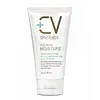What's inside
What's inside
 Key Ingredients
Key Ingredients

 Benefits
Benefits

 Concerns
Concerns

 Ingredients Side-by-side
Ingredients Side-by-side

Water
Skin ConditioningGlycerin
HumectantCaprylic/Capric Triglyceride
MaskingHydrogenated Polyisobutene
EmollientPolyglyceryl-3 Distearate
EmulsifyingGlyceryl Stearate Citrate
EmollientHydrogenated Coco-Glycerides
EmollientLimnanthes Alba Seed Oil
Skin ConditioningButylene Glycol
HumectantDiisostearyl Malate
EmollientVinyldimethicone
Lactobacillus/Soybean Ferment Extract
Skin ConditioningLactobacillus/Punica Granatum Fruit Ferment Extract
Skin ConditioningSaccharomyces/Barley Seed Ferment Filtrate
HumectantLactobacillus/Pear Juice Ferment Filtrate
Skin ConditioningPanthenol
Skin ConditioningDipotassium Glycyrrhizate
HumectantHydrogenated Lecithin
EmulsifyingMelia Azadirachta Flower Extract
Skin ConditioningOcimum Sanctum Leaf Extract
Skin ConditioningMelia Azadirachta Leaf Extract
Skin ConditioningCurcuma Longa Root Extract
MaskingCorallina Officinalis Extract
Skin ConditioningEclipta Prostrata Extract
Skin ConditioningCoccinia Indica Fruit Extract
Skin ConditioningEthylhexylglycerin
Skin ConditioningCitrus Aurantium Bergamia Fruit Oil
MaskingLavandula Angustifolia Oil
MaskingAnthemis Nobilis Flower Oil
MaskingStearic Acid
CleansingPalmitic Acid
EmollientOleic Acid
EmollientCetearyl Alcohol
EmollientHydroxyethyl Acrylate/Sodium Acryloyldimethyl Taurate Copolymer
Emulsion StabilisingGlyceryl Stearate
EmollientHydroxyacetophenone
AntioxidantSorbitan Isostearate
EmulsifyingCarbomer
Emulsion StabilisingTromethamine
BufferingPropanediol
SolventAdenosine
Skin ConditioningDisodium EDTA
Sodium Polyacrylate
AbsorbentWater, Glycerin, Caprylic/Capric Triglyceride, Hydrogenated Polyisobutene, Polyglyceryl-3 Distearate, Glyceryl Stearate Citrate, Hydrogenated Coco-Glycerides, Limnanthes Alba Seed Oil, Butylene Glycol, Diisostearyl Malate, Vinyldimethicone, Lactobacillus/Soybean Ferment Extract, Lactobacillus/Punica Granatum Fruit Ferment Extract, Saccharomyces/Barley Seed Ferment Filtrate, Lactobacillus/Pear Juice Ferment Filtrate, Panthenol, Dipotassium Glycyrrhizate, Hydrogenated Lecithin, Melia Azadirachta Flower Extract, Ocimum Sanctum Leaf Extract, Melia Azadirachta Leaf Extract, Curcuma Longa Root Extract, Corallina Officinalis Extract, Eclipta Prostrata Extract, Coccinia Indica Fruit Extract, Ethylhexylglycerin, Citrus Aurantium Bergamia Fruit Oil, Lavandula Angustifolia Oil, Anthemis Nobilis Flower Oil, Stearic Acid, Palmitic Acid, Oleic Acid, Cetearyl Alcohol, Hydroxyethyl Acrylate/Sodium Acryloyldimethyl Taurate Copolymer, Glyceryl Stearate, Hydroxyacetophenone, Sorbitan Isostearate, Carbomer, Tromethamine, Propanediol, Adenosine, Disodium EDTA, Sodium Polyacrylate
Aloe Barbadensis Leaf Juice
Skin ConditioningCaprylic/Capric Triglyceride
MaskingGlyceryl Stearate
EmollientSucrose Laurate
EmollientSqualane
EmollientHelianthus Annuus Seed Oil
EmollientCetyl Alcohol
EmollientCurcuma Longa Root Extract
MaskingGanoderma Lucidum Extract
Skin ProtectingBeta-Glucan
Skin ConditioningAvena Sativa Kernel Extract
AbrasiveGlycerin
HumectantSimmondsia Chinensis Seed Oil
EmollientChamomilla Recutita Flower Extract
MaskingCamellia Sinensis Leaf Extract
AntimicrobialBisabolol
MaskingZingiber Officinale Root Extract
MaskingTocopherol
AntioxidantButyrospermum Parkii Butter
Skin ConditioningCopernicia Cerifera Wax
Silicon
AbrasiveWater
Skin ConditioningDehydroacetic Acid
PreservativeSodium Stearoyl Glutamate
CleansingXanthan Gum
EmulsifyingBenzyl Alcohol
PerfumingCitric Acid
BufferingMaltodextrin
AbsorbentAloe Barbadensis Leaf Juice, Caprylic/Capric Triglyceride, Glyceryl Stearate, Sucrose Laurate, Squalane, Helianthus Annuus Seed Oil, Cetyl Alcohol, Curcuma Longa Root Extract, Ganoderma Lucidum Extract, Beta-Glucan, Avena Sativa Kernel Extract, Glycerin, Simmondsia Chinensis Seed Oil, Chamomilla Recutita Flower Extract, Camellia Sinensis Leaf Extract, Bisabolol, Zingiber Officinale Root Extract, Tocopherol, Butyrospermum Parkii Butter, Copernicia Cerifera Wax, Silicon, Water, Dehydroacetic Acid, Sodium Stearoyl Glutamate, Xanthan Gum, Benzyl Alcohol, Citric Acid, Maltodextrin
 Reviews
Reviews

Ingredients Explained
These ingredients are found in both products.
Ingredients higher up in an ingredient list are typically present in a larger amount.
This ingredient is an emollient, solvent, and texture enhancer. It is considered a skin-softener by helping the skin prevent moisture loss.
It helps thicken a product's formula and makes it easier to spread by dissolving clumping compounds.
Caprylic Triglyceride is made by combining glycerin with coconut oil, forming a clear liquid.
While there is an assumption Caprylic Triglyceride can clog pores due to it being derived from coconut oil, there is no research supporting this.
Learn more about Caprylic/Capric TriglycerideCurcuma Longa Root Extract is from the spice, turmeric. Besides being a healthy and delicious spice, turmeric also has plenty of skincare benefits. It has anti-inflammatory, antioxidant, and anti-microbial properties.
Turmeric contains curcumin, an antioxidant. Antioxidants help neutralize unstable free-radical molecules. Free-radical molecules may damage your skin's cells and DNA. Curcumin may help with anti-aging.
Curcumin also has anti-inflammatory properties and can help soothe skin and reduce irritation. On top of that, curcumin has been shown to help prevent hyperpigmentation from sun damage.
The anti-microbial property of turmeric can make it effective in treating acne. This property has also been shown to help regulate the production of sebum.
Learn more about Curcuma Longa Root ExtractGlycerin is already naturally found in your skin. It helps moisturize and protect your skin.
A study from 2016 found glycerin to be more effective as a humectant than AHAs and hyaluronic acid.
As a humectant, it helps the skin stay hydrated by pulling moisture to your skin. The low molecular weight of glycerin allows it to pull moisture into the deeper layers of your skin.
Hydrated skin improves your skin barrier; Your skin barrier helps protect against irritants and bacteria.
Glycerin has also been found to have antimicrobial and antiviral properties. Due to these properties, glycerin is often used in wound and burn treatments.
In cosmetics, glycerin is usually derived from plants such as soybean or palm. However, it can also be sourced from animals, such as tallow or animal fat.
This ingredient is organic, colorless, odorless, and non-toxic.
Glycerin is the name for this ingredient in American English. British English uses Glycerol/Glycerine.
Learn more about GlycerinGlyceryl Stearate is a mix of glycerin and stearic acid.
It is used to stabilize the mixing of water and oil ingredients. By preventing these ingredients from separating, it can help elongate shelf life. It can also help thicken the product's texture.
As an emollient, it helps soften skin and supports barrier-replenishing ingredients.
In cosmetics, Glyceryl Stearate is often made from vegetable oils or synthetically produced.
This ingredient may not be fungal-acne safe
Fun fact: The human body also creates Glyceryl Stearate naturally.
Learn more about Glyceryl StearateWater. It's the most common cosmetic ingredient of all. You'll usually see it at the top of ingredient lists, meaning that it makes up the largest part of the product.
So why is it so popular? Water most often acts as a solvent - this means that it helps dissolve other ingredients into the formulation.
You'll also recognize water as that liquid we all need to stay alive. If you see this, drink a glass of water. Stay hydrated!
Learn more about Water